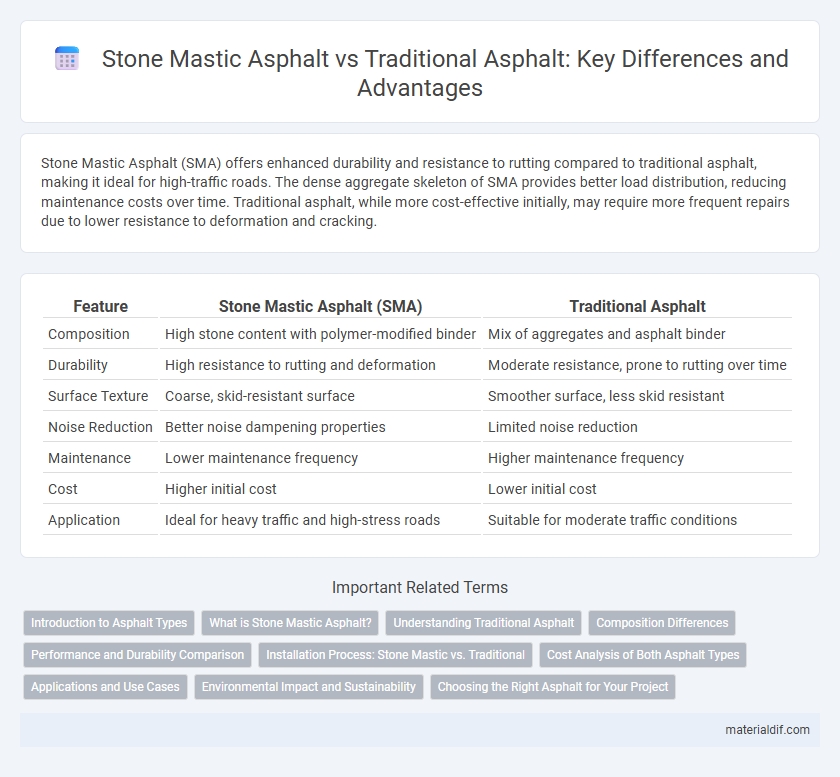Stone Mastic Asphalt (SMA) offers enhanced durability and resistance to rutting compared to traditional asphalt, making it ideal for high-traffic roads. The dense aggregate skeleton of SMA provides better load distribution, reducing maintenance costs over time. Traditional asphalt, while more cost-effective initially, may require more frequent repairs due to lower resistance to deformation and cracking.
Table of Comparison
| Feature | Stone Mastic Asphalt (SMA) | Traditional Asphalt |
|---|---|---|
| Composition | High stone content with polymer-modified binder | Mix of aggregates and asphalt binder |
| Durability | High resistance to rutting and deformation | Moderate resistance, prone to rutting over time |
| Surface Texture | Coarse, skid-resistant surface | Smoother surface, less skid resistant |
| Noise Reduction | Better noise dampening properties | Limited noise reduction |
| Maintenance | Lower maintenance frequency | Higher maintenance frequency |
| Cost | Higher initial cost | Lower initial cost |
| Application | Ideal for heavy traffic and high-stress roads | Suitable for moderate traffic conditions |
Introduction to Asphalt Types
Stone Mastic Asphalt (SMA) features a coarse aggregate skeleton designed for enhanced rut resistance and durability, making it ideal for heavy traffic roads. Traditional Asphalt, typically a dense-graded mix, provides smoother surfaces but can be more prone to deformation under load. Understanding the structural composition and performance characteristics of both asphalt types helps in selecting the appropriate pavement solution for varying traffic and environmental conditions.
What is Stone Mastic Asphalt?
Stone Mastic Asphalt (SMA) is a high-performance pavement mixture designed with a coarse aggregate skeleton that provides exceptional rut resistance and durability. Unlike traditional asphalt, SMA incorporates a higher content of filler and fibers to improve binder stability and prevent drainage voids. This composition results in enhanced load-bearing capacity and extended lifespan for road surfaces under heavy traffic conditions.
Understanding Traditional Asphalt
Traditional asphalt, commonly known as hot mix asphalt (HMA), consists of a blend of aggregates and asphalt binder heated and mixed to create a flexible pavement surface. It offers reliable performance for a range of applications but can be prone to rutting and cracking under heavy traffic and extreme weather conditions. Understanding its composition and limitations helps in comparing it with Stone Mastic Asphalt, which provides enhanced durability and resistance.
Composition Differences
Stone Mastic Asphalt (SMA) features a higher coarse aggregate content combined with a rich mortar binder composed of bitumen, filler, and fibers, providing superior rut resistance and durability. Traditional asphalt typically utilizes a more uniform aggregate gradation with a lower bitumen content, resulting in less stone-on-stone contact and reduced structural integrity. The enhanced composition of SMA promotes better load distribution and longer lifespan under heavy traffic compared to conventional asphalt mixtures.
Performance and Durability Comparison
Stone Mastic Asphalt (SMA) offers superior rut resistance and load-bearing capacity compared to Traditional Asphalt, making it ideal for high-traffic roads and heavy loads. Its stone-on-stone skeleton structure enhances durability by reducing deformation and increasing resistance to fatigue cracking under repetitive stress. In contrast, Traditional Asphalt, while cost-effective, tends to exhibit higher susceptibility to rutting and earlier deterioration in demanding environments.
Installation Process: Stone Mastic vs. Traditional
Stone Mastic Asphalt (SMA) installation requires precise temperature control between 230-275degF to ensure the polymer-modified binder forms a strong, rut-resistant surface, while traditional asphalt is typically applied at 275-325degF with a homogenous mix. SMA demands specialized equipment for proper compaction and an experienced crew to manage the thick binder-rich mix, which differs from traditional asphalt's more forgiving, uniform aggregate and binder blending. The installation of SMA often involves a longer curing time to maximize durability, contrasting with the quicker cool-down and opening-to-traffic timelines of conventional asphalt pavements.
Cost Analysis of Both Asphalt Types
Stone Mastic Asphalt (SMA) typically incurs higher initial costs due to premium raw materials and specialized installation techniques, but offers superior durability and reduced maintenance expenses over time. Traditional asphalt has lower upfront costs but often requires more frequent repairs and resurfacing, resulting in higher life-cycle costs. Evaluating both options through a comprehensive cost-benefit analysis helps determine the most economical choice for specific infrastructure projects.
Applications and Use Cases
Stone Mastic Asphalt (SMA) is ideal for heavy-traffic roads, highways, and areas requiring high durability due to its enhanced rut resistance and texture depth. Traditional Asphalt is commonly used for low to medium traffic surfaces like residential streets and parking lots, offering cost-effective performance but less resistance to deformation. SMA performs exceptionally well in harsh weather conditions and heavy load zones, extending pavement lifespan and reducing maintenance frequency.
Environmental Impact and Sustainability
Stone Mastic Asphalt (SMA) offers enhanced durability and longer service life compared to traditional asphalt, reducing the frequency of repairs and associated resource consumption. SMA's coarse aggregate structure allows for better resistance to rutting and deformation, leading to decreased maintenance emissions and material waste. Traditional asphalt mixtures often require more frequent resurfacing, thus increasing carbon footprint and raw material usage over time, whereas SMA supports sustainable infrastructure through prolonged performance and lower environmental impact.
Choosing the Right Asphalt for Your Project
Stone Mastic Asphalt (SMA) offers superior durability and skid resistance compared to traditional asphalt, making it ideal for high-traffic roads and heavy load areas. Traditional asphalt provides a cost-effective solution suitable for residential driveways and low-traffic surfaces with faster installation times. Selecting the right asphalt depends on project requirements such as load frequency, environmental conditions, and budget constraints to ensure long-term performance and safety.
Stone Mastic Asphalt vs Traditional Asphalt Infographic

 materialdif.com
materialdif.com